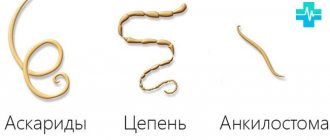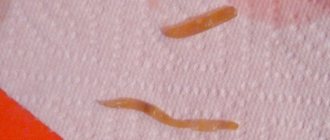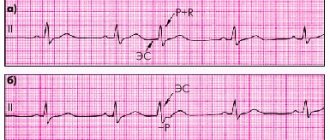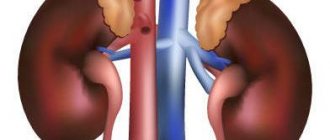What do worm eggs look like?
Often the only clear sign that a person has worms is the presence of parasite eggs in the stool.
All other signs, such as itching in the anus at night, allergic manifestations on the skin, weight loss, etc., can be symptoms of a wide variety of diseases. Often people do not know what worm eggs look like.
This is not surprising, especially considering that their shape, size, color and other characteristics can differ significantly.
Most often, attempts to visually identify worm eggs are made by parents who suspect that their children are infected with helminths.
Sometimes, when adults see strange inclusions in feces, they think that they may be eggs.
You can understand whether it is possible to detect them with a simple inspection after you familiarize yourself with their descriptive characteristics. Photos and information available on the Internet come to the rescue.
Various types
The concept of worm eggs includes spores of many species. The fact is that human worms are worms from a large order that parasitize the human body.
Most of them are localized in the upper and middle sections of the intestine, often causing various digestive disorders.
Sometimes such symptoms are perceived as a sign of pathologies of the gastrointestinal tract, but treatment does not bring results, since the true cause of the problem has not been established. A reliable diagnosis in this case is the determination of worm eggs in the feces.
Many patients believe that they can detect eggs in their stool on their own, without even knowing what they look like. To avoid such mistakes, you should familiarize yourself with more information about the reproduction of worms.
Spores and cysts in the stool can only be detected after the internal parasite reaches sexual maturity. Worms are extremely prolific creatures, so they can lay several hundred thousand cysts per day.
Such eggs are very resistant to external conditions, so it is in this form that animals spread and enter a new host. Eggs can remain viable for 4 to 6 weeks.
Most spores and cysts fall into unfavorable conditions and die, and only a few of the entire clutch will eventually turn into a mature worm. This circumstance led to very high productivity.
You can only see worm eggs through a microscope; the size of these structures does not allow them to be detected in feces with the naked eye due to their extremely small size.
They look like round or oval formations. In different species they may be slightly flattened or elongated at the upper poles.
On the surface there are always two or three layers of shell, designed to protect the internal contents from mechanical damage, drying out and other negative factors.
These shells appear as transparent, whitish, yellowish or grayish grains.
Pinworms
All pinworms are dioecious, and the mechanism of their reproduction has been well studied by specialists.
The process of mating between a male and a female occurs in the upper intestine, where ideal conditions for the sexual process are present.
After this, the female descends into the lower intestine, then emerges from the anus and makes a clutch, which contains about 25 thousand spores. Immediately after this, the female dies.
Pinworm cysts look like irregular ovals. Their miniature dimensions do not allow them to be examined, since the diameter together with the shell does not exceed 0.04 mm.
The shell is characterized by increased density, so when viewed through a microscope, laboratory assistants can easily move the eggs using special glass rods without the risk of damaging the structure.
Thanks to the reliable shell, the larva retains the ability to develop even after being at a temperature of 5-10%. At normal temperatures they remain alive for up to four weeks.
Roundworms
Roundworms, unlike pinworms, lay eggs inside the intestines. The food masses carry with them these spores, which appear at a rate of 250 thousand per day from one individual. Round spores measuring 0.07 mm in size look like oblong milky capsules. For detection, human stool is taken for analysis and examined in detail under a microscope.
Before entering a permanent host, cysts are stored in water, soil, or on animal fur, and after ingestion they develop into sexually mature individuals.
Bovine and pork tapeworm
Biohelminths, which are capable of parasitizing in the human body for 10-20 years, causing a significant deterioration in health. Infection occurs when eating foods that have not been heat-treated, since the spores are not resistant to heat.
After the parasite reaches sexual maturity, several hundred thousand cysts mature in the tapeworm body segments. These segments break off and are expelled along with feces. The eggs are slightly elongated in shape and have a grayish or yellowish color.
Tapeworms are record holders for the viability of cysts: they remain capable of further development for seven months.
Toxocars
They are considered one of the most prolific worms, capable of laying up to 250 thousand eggs per day. Compared to other species, these cysts are quite large - reaching a length of 0.1 mm.
Under a microscope, you can examine small tubercles on their surface, which help to accurately identify the parasite.
The shell is strong enough, thanks to which the cysts remain capable of further development for a month after leaving the human body.
Whipworm
The size and number of whipworm eggs depend on the condition of the parasite. Under good conditions they grow up to 0.055 mm. Cysts look like small barrels of grayish or yellowish color.
In order to open inside the human body, the spore must be mature. Ripening occurs in about 3-4 months in the soil.
Children of preschool age are most often exposed to infection due to low levels of personal hygiene.
Even if worms are present, it is not always possible to detect eggs in the stool. This is due to the cyclical reproduction of parasites. In order to obtain reliable results, microscopic analysis is carried out at least twice.
Source: https://ParazityCheloveka.ru/glisty/kak-vyglyadyat-yajtsa-glistov.html
Prevention of helminthiases
Prevention of helminthiases includes strict adherence to personal and public hygiene, adherence to food preparation technology, and implementation of measures to improve the environment aimed at reducing the number of worm eggs entering the soil. Examination and timely treatment of pets will help to avoid serious forms of helminthiasis in family members; communication with yard animals is many times more dangerous, since almost 100% of them are infected with various forms of helminths. Thorough washing of fresh vegetables and herbs is mandatory, since organic fertilizers containing parasite eggs can be used to fertilize them. Proper processing of fish (especially river fish), avoiding eating raw, dried, or lightly salted fish will help avoid infection with tapeworms.
When purchasing products of animal origin from untrustworthy sources, you must be aware that the risk of infection, including worms, is much higher than when purchasing the same products in stores and organized markets.
Parasites - How to identify parasite eggs, treatment methods, medications
Last updated March 6, 2020 at 3:56 pm
Reading time: 5 min
Infection with parasites most often occurs when the development of the pest is at the stage of a formed egg.
According to statistics, today the number of parasites infected with eggs amounts to 20% of the world's population.
Without special instruments, analyzes or research, it is impossible to detect the presence of a threat, and therefore most do not suspect that they are carriers of dangerous “cohabitants”. If you find worms or observe similar symptoms, be sure to consult a doctor.
An accurate diagnosis can only be obtained after examining stool using a microscope. Having determined the type and type of pest that has affected you, the doctor will prescribe a treatment that will save you from uninvited guests.
You can catch worms almost anywhere if you do not follow simple rules of personal hygiene: A person can acquire worms through the following foci of infection. The reason may be:
- using dirty bed linen;
- drinking untreated water that contains invisible parasites;
- eating unwashed vegetables and fruits;
- dirty hands;
- eating meat or fish without sufficient heat treatment.
In all of the above places, parasites can leave larvae, which, after entering the human body, grow into active parasitic individuals. With repeated “reception” of a portion of larvae, a person’s well-being can significantly deteriorate.
The most common causative agent of helminthiasis in humans are pinworms or roundworms. Their reproduction takes place in the anal area, as a result of which the infected person feels itching. During sleep, parasites are more active, and unpleasant sensations become more noticeable.
Infection with worms can develop into a chronic stage, and diagnosis and treatment will be much more difficult.
What do worm eggs look like?
Types of worm eggs
Helminth eggs cannot be seen without the help of a microscope. But an adult is quite easy to recognize in the masses of feces, which have come out on their own.
And yet, how to recognize worm eggs and what sizes do they come in?
Let's look at a few of the most common types:
- Roundworms reach up to 15 centimeters in length. Their habitat is in the small intestine and is white or transparent, making it easy to detect. Since the roundworm does not attach itself to the intestinal wall, the treatment process is quite quick and painless, since the worm does not damage the intestinal tissue. Ascaris is the most common parasite that infects humans.
- Pinworms are significantly shorter than roundworms - the length of the worm reaches only 1 centimeter. It can be detected either by a specialist by examining the patient’s stool, or by the patient himself. The activity of the pinworm occurs in the lower parts of the rectum, so while a person is sleeping, the worm can crawl out and lay eggs on the skin or genitals, which is why the pinworm is also a carrier of various infections.
- The bull tapeworm is very similar in its life activity to the broad tapeworm. Due to its large size, this parasite is very easy to detect. The length of an adult individual can reach even 26 meters. The size of the egg of both worms is quite visible, and it is not difficult to detect it in the stool of an infected person. You can also detect the presence of a worm in the body by examining the contents of the stool, where detached parts of the worm may be located.
How to determine the presence of worms in a person
Symptoms of worm infection
Let's consider the symptoms that signal the presence of “neighbors” in the body:
- significant weight loss, increased hunger;
- unexplained abdominal pain;
- itching and burning in the anal area;
- increased incidence of diseases associated with weakened immunity;
- drowsiness, fatigue, general weakness.
If you experience any of the above symptoms, you should immediately consult a doctor.
Detection of helminthiasis. Diagnostics
Tests of stool, urine, bile and sputum will help identify the presence and type of parasite that is causing unwanted symptoms. The habitat of eggs or mature parasites will help determine which helminth attacked your body.
By analyzing the patient's stool, parts of the worm, its larvae or eggs can be detected.
Taking tests. How to prepare?
Before taking tests, you must adhere to some rules, otherwise the test result may not show anything. The doctor must instruct the patient that:
- it is necessary to refrain from drinking alcohol;
- refrain from taking medications, especially diuretics and laxatives;
- You should definitely follow a diet, limiting yourself to meat and fish.
Preparation should begin immediately after the doctor’s prescription, with the expectation that the body needs several days to cleanse itself of substances that may affect the quality of the analysis.
Worm eggs in feces
Since active individuals often live in the colon and rectum, parts of them come out along with feces. It is in feces that helminth larvae or eggs are most likely to be found. Using a microscope, a specialist will determine which parasite is harming your body.
A small particle of the stool being tested is placed on a special surface and then stained. The particles being tested will be detected if they are present in the stool. When viewed under a microscope, eggs and other worm fragments will be visible. Such a study is carried out by a specialized doctor specializing in various types of parasites.
There are a huge number of worms that develop safely in the human body, and each of them has its own characteristics, or similarities with other representatives of its type.
Most often, children, elderly people, or adults with weakened immune systems become infected with worms.
Why do these studies?
Types of worms
- studies aimed at detecting worms or their eggs in the small intestine can identify the cause of diarrhea;
- if the individual is not found, the cause of the malaise will be sought in another way.
To do this, a complete analysis of the body is prescribed, for which the patient may be admitted to a medical institution. Be prepared for various tests, and strictly adhere to the instructions of your doctor; - By determining the type of parasite you will be diagnosed.
Depending on the type of helminths, the stage of its development and the degree of damage to the body, the doctor will prescribe treatment, regimen and diet; - the fact that the helminth is already in charge in your body is a great danger to the patient’s health.
After all, there are worms that cause significant harm to humans, affecting the lungs, liver, and intestinal walls, while causing different reactions in the body.
Scraping for enterobiasis
Scraping for enterobiasis at home
This analysis is aimed at identifying the pinworm worm. For preventive purposes, it should be done once or twice a year, especially for children. Scraping can also be done at home, as indicated in the figure above. You should not wash yourself before scraping, so as not to wash away possible particles of worms around the anus.
Follow the recommendations for proper testing. Take a cotton swab or other thin object, fixing a small amount of cotton wool on the tip.
Soak a cotton swab in the glycerin solution and move it around the hole as if you were wiping dirt from the area. After this, place the cotton wool in a sterile container, closing it with a lid.
You can immediately take it to the laboratory so that the collected particles are suitable for analysis.
As a rule, the results of the study will be known the next day, but they will probably be done faster. You can check with your doctor about the results.
How long can worm eggs live?
This question is quite important, because the likelihood of re-infection or infection of other family members depends on it. The most tenacious eggs are helminth eggs called nematodes.
Whipworm eggs can remain viable for up to several months when exposed to the outdoor environment. They are the cause of such a disease as trichuriasis.
After entering the external environment, pinworms are able to ripen within a week. The most favorable temperature for them is high temperature (up to 40 degrees). At temperatures up to 20 degrees, egg ripening occurs more slowly.
The most tenacious representatives were roundworms. In comfortable conditions, her eggs can live up to several years.
Loading…
Source: https://GemoParazit.ru/parazity/sredstva-ot-parazitov-i-ikh-yaits-kak-dejstvuyut
Symptoms
Like most diseases, helminthiasis has two stages of development: acute, which lasts from 14 to 60 days, and chronic, from six months to several years.
During the acute stage, helminths penetrate and begin to develop in the body, so its manifestations are associated with the reaction of the immune system to foreign agents and most often manifest themselves in the form of allergic reactions.
Worm eggs in the human body: what they look like and how to get tested
Types of human worms in the photo Helminths (worms) are a huge class of parasitic worms that live in the bodies of people, animals and plants. Helminths, parasitic worms, feeding on the internal resources of the “host” body not only weaken the body itself, but also contribute to the development of other associated diseases.
Oddly enough, almost every second person is a carrier of one of the types of helminths and does not even suspect it until complications arise or additional examination is carried out.
Depending on the climatic zones, different worms live on the territories of different continents. About 20 species of worms live on the territory of the Russian Federation.
Helminths are also divided according to the method of transmission from organism to organism:
- biohelminths – transmitted from animals;
- contagious - transmitted from a sick person;
- geohelminths - larvae are stored in the soil.
When larvae enter the body, they move throughout the body with the bloodstream and settle in the organs.
Most often, helminths settle in different parts of the intestine.
Classification according to the location of parasites:
- luminal helminths - settle in hollow organs;
- tissue – placed in tissues;
- others can live both in hollow organs and in the thickness of tissues.
Life cycle of development of parasites
Many parasites require both a change of host and a change of habitat to survive. To do this, helminths leave their “comfortable home” and move to the external environment or into the body of another host for the next stage of development. Thus, their full development cycle is carried out.
From this point of view, there are:
- biohelminths, which require several intermediate hosts in order to carry out their full development;
- geohelminths, which do not need to change hosts, but their certain stage of development must occur in the soil;
- contagious parasites that develop in the body of one host, lay eggs on his body and have a high invasive level.
Based on the nature of transmission of infection, the following are distinguished:
- food parasites, whose eggs are in the environment, they are not affected by ultraviolet radiation, high and low temperatures;
- contact parasites that enter the human body through wounds and damage to the skin.
When a helminthic invasion occurs and female parasites enter the human or animal body, they lay up to 250 thousand eggs in one day. Parasite eggs are very stable in the environment. They are covered with special shells that are impervious to ultraviolet radiation, cold, and the influence of special liquids. The growth and development of eggs occurs within a month, depending on the habitat.
If parasite eggs enter the human body, then under the influence of gastric juice their shell is destroyed and the larvae are released.
The larvae are absorbed into the blood vessels and, together with the blood flow, move throughout the body, stopping in one organ or another. In this way they migrate and spread throughout the body.
However, their growth, nutrition and development occurs only in one specific organ, for example, in the pulmonary alveoli, or the liver, or the heart, or in the small intestine. The grown larvae penetrate the bronchi, from there into the nasopharynx and are swallowed again.
Once in the intestines, they rapidly grow and develop, becoming a sexually mature individual. Their final development and reproduction occurs in the intestine. The eggs then penetrate the large intestine and are passed out together with the stool.
How to treat
Drits Irina Alexandrovna. Parasitologist Helminth infections can lead to numerous health problems, shortening life by 15-25 years. Many parasites are extremely difficult to detect. They can be anywhere - in the blood, intestines, lungs, heart, brain.
Symptoms of helminthic infestation can be confused with ARVI, gastrointestinal diseases and others. The main mistake in such cases is delay! If you suspect the presence of parasites, you need to contact a specialist.
If we talk about medications and self-treatment, then this antiparasitic complex .
Today, a parasitologist has over 10 anthelmintic drugs in his arsenal, which have their own specific activity against various types of worms.
The main drugs for the treatment of worms:
- Piperazine (10-30 rub.);
- Pyrantel - Helmintox (80-120 rub.);
- Pirantel (30-50 r);
- Nemocid, Combantrin Mebendazole - Vermox (90 rubles);
- Vermakar, Mebex, Vero-Mebendazole, Thermox, Vormin (20 rubles);
- Albendazole - Nemozol (120-150 rubles);
- Gelmodol-VM, Vormil Levamisole - Dekaris (70-90 rubles);
- Carbendacim - Medamin (70-90 rubles);
- Pyrvinium embonate - Pyrivinium, Pyrkon, Vanquin.
What do worm eggs look like?
Since worm eggs are microscopic in size, you can only find out what they look like using a microscope. They cannot be seen with the naked eye. To determine the type of helminth parasitizing in the human body, a microscopic examination of feces is performed.
When detecting eggs, experts pay attention to their shape, color, size and appearance, since these characteristics can fairly reliably diagnose the class of helminth. Sometimes fragments of the largest helminths can be seen in feces, but even in this case it is not always possible to accurately determine their type.
Only specialists can detect parasite eggs in feces.
The appearance of eggs of different parasites has its own specific characteristics.
Preventive actions
The main and indisputable condition for preventing helminth infection is frequent washing of hands, vegetables, and berries. Preventing worms in pets will also protect humans from infection. High-quality cooking will neutralize worm eggs if they are present in fish and meat. When working in the garden, it is better to use gloves.
Pinworm eggs
Pinworms cause a very common disease called enterobiasis. We can say that this is the most common infection of all helminthiases.
Pinworm eggs have amazing persistence, so they are distributed everywhere in the environment, due to their high ability to invade and easy contact transmission.
This disease is especially common among young children who do not yet know how to maintain personal hygiene.
Pinworm eggs are asymmetrical and oval in shape. On the one hand they are convex, on the other they are flat. The surface of the eggs is covered with a colorless double-circuit shell with dimensions of 0.050-0.060, 0.02-0.03 mm.
Pinworm eggs are never found in feces because they are not there. To detect them, it is necessary to scrape the worm egg or scrape it for enterobiasis. Why is that? The fact is that for the development of pinworm eggs, favorable temperature conditions are necessary.
In other words, a certain temperature that is close to the temperature of the human body: approximately 34–36°. Also, pinworm eggs need a certain air humidity. Female pinworms lay eggs where the relative humidity is between 75–90%.
The best places for laying eggs are the perianal folds, and night time is the most favorable for laying eggs. At night, when a person sleeps, his sphincter is relaxed, and the female comes out freely.
However, the movement of the female causes severe itching in a person, and the sleeping person tries to comb the places where the eggs are laid. The area being scratched is constantly disturbed by the fingers and thus the infection spreads everywhere around the person. Thus, regular re-infection with pinworms occurs.
The male pinworm dies immediately after mating, and the female after she lays eggs. Literally after 5–6 hours, pinworm eggs already become invasive. The next stage of pinworm development occurs in the intestines, so the eggs must be swallowed by a person. This is not difficult at all since they are found everywhere in the environment.
They can be found:
- on children's toys;
- on underwear;
- on bed linen;
- on the dog's fur;
- on door handles;
- on personal belongings;
- on common items;
- in the air and in the dust.
To prevent infection, it is enough to maintain personal hygiene, keep a person’s home clean, do wet cleaning every day, and change underwear and bed linen every day. It is enough to wash both underwear and bed linen at temperatures above 70°, since pinworms die within 10 minutes already at 50°.
Conditions of destruction
To kill worm eggs, it is necessary to carry out a special program. Taking anthelmintic drugs is directed against adult individuals and cannot destroy the spores of the parasite. The following conditions are detrimental to worm spores:
- air temperature above 50ᵒС;
- water temperature above 70ᵒС;
- air humidity less than 10%;
- temperature drop below 5ᵒC.
How to properly submit a scraping for enterobiasis?
Scraping for enterobiasis should be carried out before morning bowel movements and hygiene procedures. If you wash off the eggs during morning water procedures, the analysis will lose all information content. It is better to take a scraping at a clinic, but if this is not possible (the child may be capricious), then you can do it at home.
To do this, you need adhesive tape, a clean container and a cotton swab or a special spatula. Adults can use a cotton swab to scrape the perianal folds themselves, while a child can apply adhesive tape to the folds around the anus, then carefully remove it and place it in a container.
For an accurate diagnosis, scrapings for worm eggs are taken within three days. A threefold positive result is considered reliable.
Disinfectants
To destroy worm spores in the apartment, the most effective anthelmintic agents are used. Preference is given to the following means that are safe for humans:
- a solution of 3% hydrogen peroxide is added to water for washing floors and walls;
- the surfaces of wooden objects are treated with linseed oil;
- You can add acetic acid and table salt solution to the solution;
- the surfaces of bathtubs and toilets are treated with a solution of carbolic acid;
- special products – Dezaktin containing chlorine;
- air treatment with bactericidal (ultraviolet) lamps, ozonizers.
Ascaris eggs
Roundworms are also a fairly common type of helminth. However, they penetrate into the human body from the environment, since they are geohelminths and one stage of their development occurs in the soil.
Ascaris eggs are very stable in the environment and can wait a long time for potential prey and favorable conditions for their further development.
They enter the human body along with poorly washed vegetables, herbs, fruits and berries.
https://www.youtube.com/watch?v=SmJgK4rZCOg
Once in the human body, the eggs are destroyed by gastric enzymes and the larvae are released. The larvae, penetrating the blood, migrate throughout the body, entering the lungs, heart, and then again into the digestive system, where they become sexually mature individuals capable of reproduction.
Adult worms are clearly visible in feces, since they are quite large helminths of white and pink color. Pinworms usually measure about 15 cm.
Ascaris eggs cannot be observed in feces with the naked eye; they, like the eggs of other parasites, are microscopic in size.
Sometimes fragments of roundworms can be seen in the stool, but to confirm the diagnosis it is necessary to test the stool for worm eggs. The female roundworm is very fertile, she is capable of laying hundreds of eggs per day.
Ascaris eggs have an oblong shape (sometimes they are round) and are dark yellow in color. Their shell has a specific tuberosity. They can be either fertilized or unfertilized.
Main symptoms and development of the disease
Widespread morbidity is related to the number of infected patients. People with a mild infection usually have no significant symptoms.
More severe forms of infection can cause a range of adverse effects, including bowel dysfunction (diarrhea and abdominal pain), general malaise and weakness, and impaired brain function and physical development.
This unpleasant disease causes chronic blood loss from the intestines, which can lead to anemia.
Source: https://gb4miass74.ru/bolezni/glisty-simptomy-u-vzroslogo.html
Diagnosis of helminthiases
Due to the diversity of types and manifestations of the disease, careful attention and careful questioning of the patient are of great importance, helping to identify possible causes of infection. The study of biological materials (feces, rectal mucus, bile, contents of the duodenum, blood, sputum from the lungs, muscle tissue) is carried out in order to identify whole or fragments of parasites and their eggs. When performing simple clinical blood tests, an increased number of one type of white blood cell, eosinophils, may suggest parasites. In some cases, more complex immunological blood tests are carried out in order to identify antibodies to certain types of parasites. X-ray and ultrasound examinations, computed tomography, and endoscopic examinations can provide great assistance in diagnosis.
What size are worm eggs?
Do you want to know what worms look like in human feces? Most will most likely refuse this dubious pleasure.
This is indeed an unpleasant sight, but helminthologists have to carefully examine these worms and their larvae in order to find out which worms and worm eggs have entered the body of a person who has helminthiasis.
What to do? To begin with, we recommend reading an article from the main institute of parasitology of the Russian Federation. This article reveals a method by which you can cleanse your body of parasites, without harm to the body. Read the article >>>
Worms (helminths) are far from harmless. Not only do worms absorb microelements and other nutrients that are vital for human health, they also cause general depression of the body due to the release of toxic products of their vital activity, which is especially dangerous for children.
Therefore, detecting these worms and getting rid of them is a very pressing problem.
But first, let's find out what worms are, what they look like in an adult and a child, what symptoms indicate that a person has become infected with these pathogenic worms, and, finally, what treatment will be the most effective.
What are worms
Helminths, or colloquially worms, are worms that parasitize the human body. To date, science knows more than 200 species of such worms, not counting their exotic varieties found in the tropics and subtropics.
According to the accepted classification, there are three classes of these worms that pose the greatest danger to humans:
- flat tape;
- round – nematodes;
- trematodes, or flukes.
Tapeworms
The first class - tapeworms (flatworms) includes the broad tapeworm, bovine tapeworm (bovine tapeworm), pork tapeworm (pork tapeworm), etc.
Their larvae enter the human body from animal meat or fish that have not undergone sufficient heat treatment.
Wide tapeworm , reaching a length of 10 m, is considered one of the largest worms. Its larvae live in fish, and it is with caviar and fish fillets that it enters the human body.
This worm is extremely fertile - its female lays several million eggs every day, which are contained in the feces.
The eggs are yellow-brown in color and oval in shape with a tubercle at one end and a cap at the other.
Are eggs visible to the naked eye? It is impossible to see them, although the size of the eggs of the broad tapeworm is considered to be quite large and is about 70 micrometers.
The bovine tapeworm is a kind of long-liver: it can exist in the human intestine for 18 to 20 years, laying about 600 million eggs per year.
Eggs with infective larvae first enter the body of cattle and, after a series of transformations, enter the human body. It is he who is the only and final “master” for this worm.
Infection with bovine tapeworm occurs when consuming poorly fried or cooked meat, which should be remembered by all lovers of rare steaks.
Pork tapeworm enters the human body in a similar way, but if the range of intermediate hosts for bovine tapeworm is limited to cattle, then hares, rabbits, dogs, and camels can also act as carriers of pork tapeworm, along with pigs.
Therefore, when preparing pork, hare and rabbit meat, correct (that is, sufficient) heat treatment plays an extremely important role.
Roundworms (nematodes)
What doctors say about treating parasites
Doctor of Medical Sciences, Professor German Shaevich Gandelman
Work experience: more than 30 years.
I have been detecting and treating parasites for many years. I can say with confidence that almost everyone is infected with parasites. It's just that most of them are extremely difficult to detect. They can be anywhere - in the blood, intestines, lungs, heart, brain.
Parasites literally devour you from the inside, at the same time poisoning your body. As a result, numerous health problems appear, shortening life by 15-25 years.
The main mistake is delaying! The sooner you start removing parasites, the better. If we talk about medications, then everything is problematic.
Today there is only one truly effective anti-parasitic complex, this is TOXIMIN.
It destroys and sweeps out all known parasites from the body - from the brain and heart to the liver and intestines. None of the drugs existing today is capable of this.
Within the framework of the Federal program, when submitting an application before June 10. (inclusive) every resident of the Russian Federation and the CIS can receive one package of TOXIMIN FOR FREE!
To date, about 24,000 (!) species of these parasites are known, affecting not only humans and animals, but even plants.
The most common infections are roundworms and pinworms due to neglect of personal hygiene rules and consumption of contaminated food and water.
Roundworms are round, translucent worms up to 40 cm long in females and 25 cm long in males. They are able to penetrate through the intestinal walls into the circulatory system and, together with the blood flow, spread throughout the body, becoming established in its various organs and causing their dysfunction.
These worms usually cause allergic reactions in humans, which can result in skin rashes or asthmatic symptoms.
People often confuse ascariasis with completely different diseases characteristic of the organ where these worms have nested. Detection of roundworm eggs in feces, and therefore diagnosis, is somewhat difficult.
Pinworms are thin gray-white worms up to 1 cm long. These worms are among the most common parasites and have one interesting feature: eggs are laid not in the feces, but outside the host’s body.
To do this, female worms emerge from the anus at night and lay eggs near it, as well as in the perineum and folds of the buttocks. They look like small white grains of a slightly elongated shape and are visible to the naked eye.
This is what white worms look like in human feces
All this causes severe itching, and as a result of scratching the skin with pinworm eggs, re-infection occurs due to their getting under the nails, on the hands, underwear, etc. Pinworms are very common in children; they can be seen in feces in the form of small thin whitish worms.
Fluke worms (trematodes)
Worms of this class can have both round and flat shapes. They have a complex life cycle; they can affect many human organs.
Their eggs are usually found in feces. Of the 7,200 species of trematodes described to date, about 40 species are human worms.
The most famous of these flukes is the liver fluke, which lives in the bile ducts of the liver. She, or rather, her juices serve as food for this parasite.
Source: https://ParazitHelp.ru/parazity/kakogo-razmera-jajca-glistov.html
Helminths in humans
They feed at his expense. They don't kill him, but slowly poison his life. This is what distinguishes them from predators. It is not at all profitable for parasites to immediately kill their victim. They are configured for long-term existence in the human body. This is not a voluntary alliance. In such a violent union, only the parasites benefit. They slowly poison and ruin human life. From the photo of worms you can see how diverse and disgusting they are. It’s unpleasant to even look at them, and it’s simply scary to imagine these monsters inside yourself. It’s also scary that not all of them can be diagnosed and neutralized. Some of their types skillfully hide in a person, preventing doctors from even understanding what is happening to him. Often people try to treat diseases without even suspecting that the main culprit of their ailments is a parasitic worm. Photos of worms in humans are direct confirmation of this. They show how some of the parasites are quietly located in the organs, merging with the overall picture of the living mechanism, parasitizing, developing and poisoning life. Many documentaries have been made about what worms look like in humans. All photos, pictures, films, articles are created in order to convey to people more information about these terrible creatures, to try to protect them from them, as well as to find and neutralize them.












